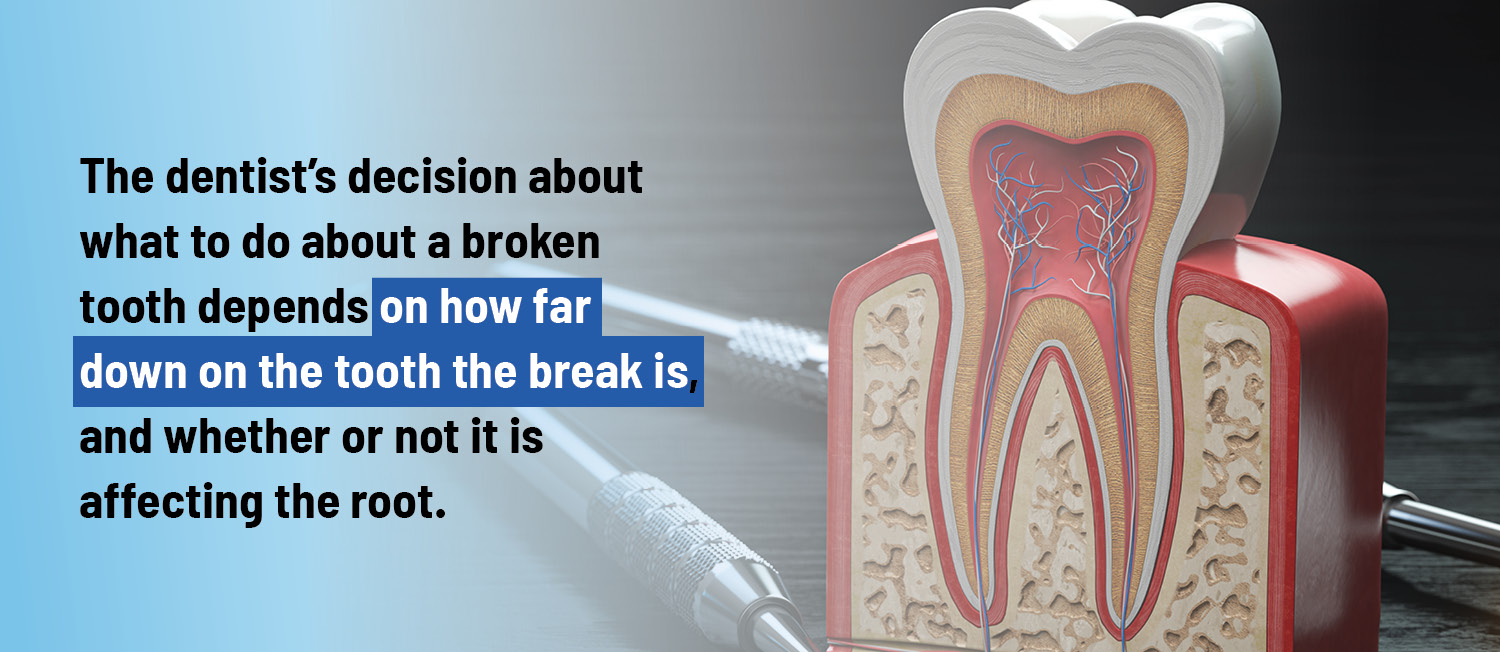Imagine you’re enjoying your favorite snack, and suddenly, you feel a sharp crack in your mouth. You spit out the food and, to your horror, discover that your tooth has broken in half. This situation can be scary and painful, but don’t worry—there are steps you can take to handle it. Whether it’s a broken molar or a chipped tooth, understanding what to do next can make a big difference in your dental health. The first step is to call the dentist to determine how soon you need an appointment.
In the meantime, here are the things to know and steps to take for everything from a tiny dental fracture to a clean, complete break.
What to Do When You Break a Tooth
It is crucial for a patient to see the dentist as soon as possible when they break or chip a tooth. A broken tooth will not heal on its own, and ignoring it can lead to more serious problems like infection or tooth loss.
A very small chip or crack without pain can usually wait until the next scheduled checkup. Call the dentist immediately if a broken tooth is painful or bleeding. However, even with a bad break, you might not feel pain or see any blood. These things usually mean that the break is not an emergency—but you should make a dental appointment anyway.
If there is severe bleeding that will not stop, or if the broken tooth happened in an incident with other injuries, it is best to go to an emergency room.
In addition to contacting a dentist, there are a few things patients can do to help save a broken tooth and manage discomfort.
Save the Broken Tooth
If your tooth is broken, there are a few steps you can take to preserve the pieces. If the patient is able to go directly to the dentist, gently rinse the broken piece with water or saline solution and place it back into the gum. (If an entire tooth is knocked out, hold it only by the crown and not the roots.)
If it is not possible to go to the dentist immediately, try storing the tooth or broken parts in a small container of saline solution, water with a bit of salt, or a store-bought product like Save-a-Tooth. In many cases, this can preserve the material for up to 24 hours, and this may help the dentist repair the tooth more effectively.
Rinse the Mouth
Rinse with warm water to clean the area around the broken tooth. This will help remove any food particles or bacteria that might cause infection. If there is bleeding, gently bite down on a piece of gauze or a clean cloth to help stop it.
Manage Pain
A broken tooth can be very painful, especially if the nerve is exposed. To manage the pain, patients can take over-the-counter pain relievers like ibuprofen or acetaminophen. Be sure to follow the instructions on the label. Applying a cold compress or ice pack to the outside of the cheek near the broken tooth can also help reduce swelling and numb the pain.
Avoid Certain Foods
When dealing with a broken tooth, it is best to avoid hard, crunchy, or sticky foods that could cause more damage. Patients may also find it more comfortable to avoid very hot or very cold foods and chew on the opposite side of their mouth until their tooth is repaired.

How Does the Dentist Fix a Broken or Chipped Tooth?
The dentist often has a simple solution to fix minor problems like small chips. Serious breaks, (for example, if a molar broke in half), might need more complex treatment. For these emergency dental situations, it is important to see the dentist as soon as possible.
The following methods are the most common fixes for cracks, chips, and broken teeth:
- The dentist might be able to smooth out a small chip using a dental file.
- Dental filling material can close cracks or fill chips that have not damaged too much of the enamel.
- Veneers are good for covering the front side of teeth to conceal chips, cracks, or breaks on the front-facing surface of visible teeth.
- Dental bonding can work like a veneer. It might also be used to cement a broken chunk of the tooth back into place.
- When a tooth is badly damaged, it might need a dental crown. A crown is made to look and feel like a real tooth, placed on top, and sealed to keep out future decay. This might also be the best option if a molar broke in half.
- When a break is deep enough to damage the root or pulp chamber, the dentist might recommend a root canal procedure. They will remove the soft tissue at the center of the tooth, then finish it off with a crown.
- If a tooth breaks down below the gum line, or if the root fractures and splits in two, the only option might be extraction. Once the tooth is pulled, the patient can choose a restoration such as dentures or a dental implant.
The dentist’s decision about what to do about a broken tooth depends on how far down on the tooth the break is, and whether or not it is affecting the root. Their priorities will be first to alleviate the pain and then protect the tooth’s integrity. This means sealing it off from bacteria and making sure it is structurally strong. Finally, they will restore the tooth’s look.
What Happens If Broken Teeth Go Untreated
It is a bad idea to ignore damaged teeth since they will not heal on their own. There is often pain and swelling when a tooth breaks off. And if the break goes deep enough, the tooth may bleed and be sensitive to heat and cold. It might hurt to bite down in that area, making eating difficult.
A jagged edge from a dental fracture or break is likely to be uncomfortable rubbing up against the sides of the mouth or the tongue. And if the break is on a front tooth, there is the obvious issue of how it looks.
Another problem with leaving a broken tooth alone is that it interferes with the way the teeth come together when the patient talks and chews. This can cause jaw pain and make the jaw and teeth shift to accommodate the imperfect bite.
In addition to problems of discomfort or cosmetics, a broken tooth can lead to more serious dental issues. Any breach of the tooth enamel leaves the tooth’s inner layers exposed to bacteria. Letting bacteria in can cause cavities. Worse, if a crack or break goes all the way down to the root, an infection can attack the nerves and blood vessels at the core of the tooth. This can result in a dental abscess or pulpitis. A root canal procedure or even extraction might be necessary.
Finding a Dentist for a Broken Tooth
Whether your tooth is chipped or broken in half, it is important to call a dentist. It is not always obvious how bad the break is without a dentist’s expertise. Better to make an appointment and get a quick fix than to suffer later with a bad cavity or a damaged root.
For emergency dental care or to find a regular dentist, use our online search tool. Our extensive database has dental professionals in your area.


